Maverick and Comet Repair
1966-74 MOTORCRAFT (AUTOLITE) POSITIVE ENGAGEMENT
DESCRIPTION
Four pole, four brush starter with three
series of coils and one shunt coil. Shunt coil is wound around a
movable pole piece which operates the integral positive engagement
drive mechanism.
TESTING
Starter Cranking Circuit Test - Make test
connections as shown in illustration. Crank engine with ignition off
(disconnect and ground high tension lead from coil and connect
jumper from battery terminal of starter relay to "S" terminal of
relay). Maximum allowable voltage drop should be as follows:
- With voltmeter negative lead connected to starter terminal and positive lead connected to battery positive terminal (connection I), voltage drop should not exceed .5 volt.
- With voltmeter negative lead connected to battery terminal of starter relay and positive lead connected to battery positive terminal (connection 2), voltage drop should not exceed .1 volt.
- With voltmeter negative lead connected to starter terminal of starter relay and positive lead connected to battery positive terminal (connection 3), voltage drop should not exceed .3 volt.
- With voltmeter negative lead connected to negative terminal of battery and positive lead connected to engine ground (connection 4), voltage drop should not exceed .1 volt.
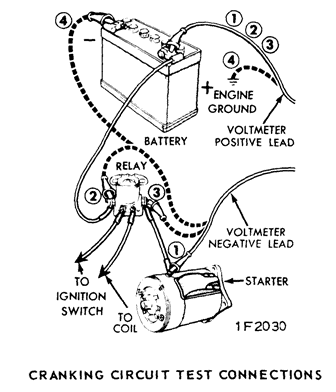
Starter Load Test -
Make test
connections as shown in illustration. NOTE - Make sure no
current is flowing through ammeter and rheostat is at maximum
counterclockwise position. Crank engine with ignition off
(disconnect and ground coil high tension lead and connect jumper
from battery terminal of starter relay to ignition switch terminal
of relay). Note voltmeter reading. Stop cranking engine, reduce
resistance of carbon pile until voltmeter indicates same reading as
when cranking. Ammeter now indicates current draw under load.
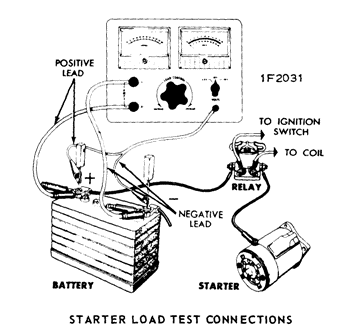
Starter No-Load Test -
Make test
connections as shown in illustration. NOTE - Make sure no
current is flowing through ammeter (rheostat at maximum
counterclockwise position). Note exact reading on voltmeter.
Disconnect starter from battery and reduce resistance of rheostat
until voltmeter indicates same reading as when starter was running.
Ammeter will indicate starter no-load current draw.
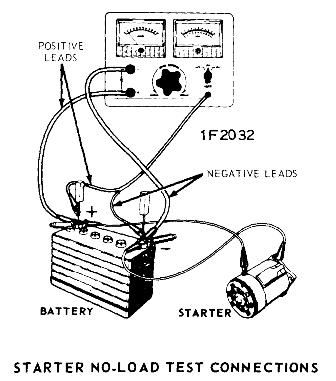
Armature -
Check armature for
shorted coils with a growler. Test for grounded coils with a test
lamp or voltmeter and battery connected in series, by touching one
test probe to commutator and other test probe to core or armature
shaft. If test lamp lights, or voltmeter shows any reading, coils
are grounded. Commutator should be clean and smooth. If commutator
burned, or out-of-round more than .005", turn down in a lathe and
sand lightly with 00 sandpaper.
Field Coil -
Check for open or
grounded coils with test lamp or voltmeter and battery connected in
series. Make sure insulated brush leads are clear of frame, block
drive coil contacts (on frame) open by inserting insulator between
contacts, disconnect holding coil ground lead from frame. Touch one
test probe to coil lead, other probe to frame. If lamp lights or
voltmeter shown any reading, coils are grounded. Test for open coils
by placing one test probe to field terminal and other probe to
insulated brush lead. Lamp should light or voltmeter should show
reading
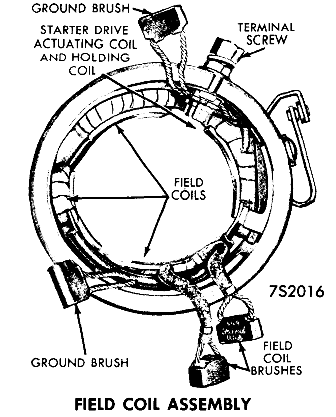
Brushes & Springs-
Check brush
holders for broken springs and insulated brush holders for shorts to
ground. Tighten any loose rivets. Replace brushes if worn to !A" in
length.
SPECIFICATIONS
Cranking Amperage
Draw — 150-200 amperes with a normal cranking speed of 180-250 RPM
(4" diameter starter). The 4'/2" diameter starter should draw
150-180 amperes with a normal cranking speed of 150-290 RPM.
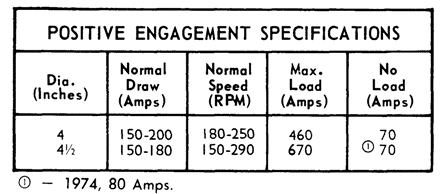
Brush Spring Tension —
40 ozs. (4"
diameter starter). The 4'/2" diameter starter should have 80 ozs.
Rotation —
Clockwise at drive end.
OVERHAUL
DISASSEMBLY
- Remove brush cover band and starter drive lever cover. Remove brushes from brush holders (note lead positions for assembly). Remove through bolts, starter drive end housing and starter drive plunger lever return spring. Remove actuating lever pivot pin. Remove lever and slide armature out.
- Remove stop ring retainer. Remove and discard stop ring retaining starter drive gear to end of armature shaft, then remove starter drive gear assembly. Remove brush end plate. Remove screws retaining ground brushes to frame. Bend tab up on field coil (which operates drive gear actuating lever) retaining sleeve, remove sleeve.
- Remove coil retaining screws. Unsolder field coil leads from terminal screw, remove pole shoes and coils from frame. Unsolder insulated brush leads from field coils. Remove starter terminal nut, washer, insulator and terminal from starter frame.
CLEANING
Use a brush or air to
clean field coils, armature, commutator and armature shaft, front
end plate and rear end housing. Wash other parts in solvent and dry
with air.
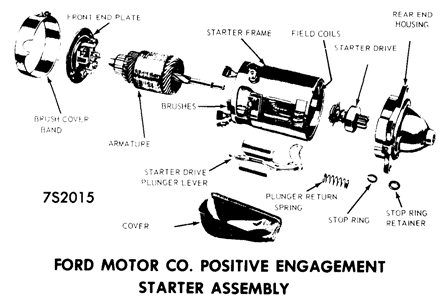
REASSEMBLY
- Install starter terminal, insulator, washers and retaining nut. NOTE - Position slot in screw perpendicular to frame end surface. Position coils and pole pieces (with coil leads in terminal screw slot), install retaining screws. As screws are tightened, strike frame several sharp blows with soft-faced hammer to seat and align pole shoes, then stake screws.
- Install solenoid coil and retainer and bend tabs to retain coils to frame. Solder field coils and solenoid wire to starter terminal using rosin core solder. Check for continuity and grounds in assembled coils. Position new insulated brush leads on field coil terminal (use clip provided with brushes to hold brush lead to terminal), solder lead, clip, and terminal with rosin core solder.
- Position solenoid coil ground terminal on nearest ground screw hole, position both ground brushes and install attaching screws. Position commutator end plate on frame with end plate boss in frame slot. Apply thin coating of lubriplate on armature shaft splines, install drive assembly on shaft, then install new stop ring and retainer. Position fiber thrust washer on commutator end of armature and position armature in starter frame.
- Position starter drive gear plunger lever to frame and starter drive assembly, install pivot pin. Partially fill drive end housing (approximately !/4 full) bearing bore with grease. Position drive plunger lever return spring and drive end housing to frame, install and tighten through bolts to 55-75 inch Lbs. CAUTION - Do not pinch brush leads between plate and frame. Make sure stop ring retainer is seated properly in drive housing.
- Install brushes in brush holders, centering springs on brushes. Position drive gear plunger lever cover on starter and install brush cover band with a gasket. Tighten band retaining screw. Check starter no-load current draw.